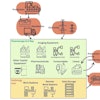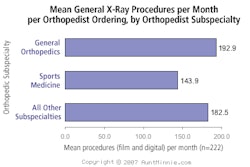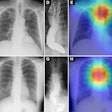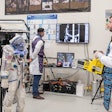
Because of the inherently different technologies that are involved, it is not trivial to ensure that digital images, as generated by either digital or computed radiography (DR/CR), are presented to physicians in a format similar to what they are used to in the hard-copy (film) world. It is not sufficient to merely match the functionality and presentation of film; because of the digital nature of CR and DR technology, it is even more important to capitalize on the advantages that this digital media provides.
For healthcare professionals who are jumping into digital radiography, it is important to understand image quality issues. This article lists the most common issues and describes how to be prepared for them.
Use of different techniques
One cannot use exactly the same exposure techniques (kVp, mAs) as one uses for film. Unfortunately, there is no "golden rule" because technique changes vary for each manufacturer. Even for a particular manufacturer, it depends on the type of screen or detector that is used.
Vendors are introducing new technologies, such as double-sided CR plates, and new compounds for their screens so that the sensitivity is increased. In general, CR plates appear to require a greater dose to get to the same level of image quality; however, as stated, it depends heavily on the plate manufacturer.
The bottom line is that changes are very likely needed; ignoring this can definitely impact your image quality. Work closely with your vendor to implement a new set of techniques.
Danger of 'dose-creep'
CR/DR image acquisition is very forgiving. That means that an exposure that would have been too light or too dark -- under- or overexposed and possibly requiring a retake in the film world -- is still usable in the digital world.
However, incorrect exposure in either direction is not a good thing: too few photons create too much noise in the image, while too many might reduce contrast. Because immediate feedback is missing (the image is always generated with proper contrast), the tendency appears to be that technologists are gradually increasing the exposure.
In addition to having an impact on the image quality, there is definitely an inverse impact on patient radiation and safety. A QA/QC process is needed to monitor this.
QA/QC process
A QA/QC process is critical, not only to monitor for dose creep, but also to ensure that the proper processing is applied (yes, the software can -- in isolated cases -- apply image processing in a nonoptimal manner).
In addition, one might have to apply shutters, rotate and/or flip images, and apply an appropriate window width level. In most cases, a QA tech or technologist supervisor initially performs this role. Eventually, this job is pushed back to the technologists performing the exams, assuming they had plenty of opportunity to be trained.
Reject analysis
In isolated cases, the image undergoing QA could be deemed to be unsatisfactory. This could be due to patient movement, the required anatomy is not shown, improper technique was used, or several other reasons.
In the film world, the number of rejects was easy to track -- one could just review the contents of the "reject" bin and do an analysis. The equivalent of the reject bin is the recycle bin on the workstation; however, someone needs to review these rejects, match them with the technologist performing the exam, analyze the results, and, on a monthly basis, schedule retraining and/or make changes in workflow to reduce these occurrences in the future.
A process is needed, which could depend on the CR or DR vendor's architecture. For example, some institutions mark the images with a specific reject code and send them to the PACS in a way that they end up in a special directory, some institutions save them on the QA workstation, some save them at the CR/DR unit, and so on.
Differences in image processing
Particularly with DR systems, there is a wide range of image processing those results in a different "look" to the image.
One has to realize that detector behavior is quite different than the response of a film to x-ray energy. In many cases, the output of the detector is linear, which means that to match the look of what this image would look like if it had been taken on a film, the vendor has to apply image processing and/or lookup tables (LUTs) to the data.
Imagine that you have two different systems from two vendors, and you need to compare images that are taken on these systems -- they could very well look quite different. Even if all your digital x-ray equipment is provided by one vendor, there is the distinct possibility that a patient will bring in their previous images on a CD, which may have been taken on a system from a different vendor.
One solution to this challenge is to configure your digital systems to have them send the unprocessed data with the applicable LUT as part of the image header, and then have viewing software that can apply either the original or a universal LUT to these images.
Collimation is critical
The impact of scatter radiation is even more pronounced on CR, and particularly on DR. If one does not properly collimate the area to be exposed, the result is unacceptable image quality. This is especially important with imaging extremities. Thorough training of the technologists is necessary.
Improper body part selection
Each body part is processed with specific algorithms to optimize specific data characteristics of that anatomy. This means that if one accidentally selects a chest study as an extremity study, the resulting image will look unsatisfactory.
It is possible to go back to the acquisition device and reprocess the raw data to end up with a better image. Again, proper training of the technologists is critical to avoid these types of issues.
Hanging protocols are important
One could consider the presentation of images on a screen as part of image quality. A specific hanging protocol for a physician could require the posteroanterior (PA) view to be on the left screen, and the lateral (LAT) on the right. However, in the ICU one might want to compare all PAs with one another, which is different than how they are presented in the ER. In addition, some physicians might want to see the images in their own preferred order.
For an outsider, this might seem like a minor issue; however, for a radiologist, who has been trained to look at images in a certain position in a certain order, this is a major issue. Hanging protocols often depend on information that is available in the image header, such as "Series Description" or "Body Part," to generate the proper order. This information is generated through user interaction and/or data entry at the CR/DR technologist console.
Proper training and the awareness of the impact of incorrect selections by the technologist are crucial.
Cassette cleaning is critical
This is especially important for CR. The cassettes that are used typically collect dust. This can be seen on the images, and can even damage the plates by creating scratches if it gets inside the CR readers.
The solution is quite simple: once a month, or more often if the environment is dusty, take each plate out of its cassette and clean it with alcohol or a vendor-recommended solution.
Someone must be assigned to this task -- the imaging librarians working in the file room might be a good resource for this job.
Monitor quality needs to be monitored
This is not only applicable for CR/DR but for any digital modality -- consistency and integrity can only be achieved if soft-copy monitors are regularly calibrated. In many cases, flat-panel displays can be remotely monitored and/or automatically configured to start the calibration process -- for example, every Sunday at midnight. If there is no automatic monitoring, someone needs to do it manually.
Conclusion
The implementation of CR/DR introduces several new activities, which should be properly documented as a set of policies and procedures that spell out exactly who is doing what and when, which also can be used as the basis for training. Having these policies and procedures in place is an important step toward eliminating most issues that occur commonly when introducing CR and DR technology.
By Herman Oosterwijk
AuntMinnie.com contributing writer
April 12, 2007
Reprinted from www.otechimg.com by permission of the authors. To receive the regular OTech newsletter, visit www.otechimg.com/newsletters.cfm?menu=pubs or visit www.otechimg.com for information on PACS training classes, books, and e-learning.
Related Reading
Strategies for reducing 'dose creep' in digital x-ray, April 11, 2007
Study suggests ways to cut CR radiation, March 5, 2007
Korean rads find no edge for high-res CR in chest exams, January 22, 2007
Study: DR delivers lower radiation dose, November 7, 2006
U.S. hospitals find ways to take the digital x-ray plunge, October 12, 2006
Copyright © 2007 OTech Health Care Technology Solutions



















